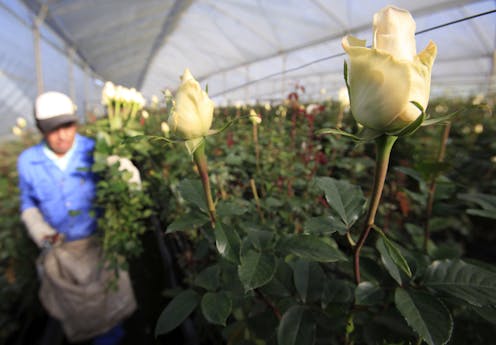The flowers you buy your mom for Mother's Day may be tied to the US war on drugs
- Written by Jay L. Zagorsky, Senior Lecturer, Questrom School of Business, Boston University

What does Mother’s Day flowers have to do with cocaine?
Very little, most people would think. But as an economist, I often explain[1] to my students that the world is economically connected, often in strange ways. The flower business is one of those strange economic connections.
Mother’s Day, which this year falls on May 10, is typically big for the American floral industry, which depends on it for over a quarter of all holiday flower sales[2]. It’s especially important to flower vendors this year as the coronavirus has ravaged the industry[3], affecting both supply and demand.
About a third of cut flowers[4] purchased in the U.S. come from California, while the rest are imported. About 80% of those[5] come from Colombia or Ecuador.
The story of how both countries became such an important source of flowers for the U.S. can be traced back to the U.S. war on drugs[6].
In the late 2000s, the U.S. and Colombian government were looking for new ways to stem the flow of cocaine[7] into the U.S. Part of the strategy involved law enforcement: increasing interdictions[8] to stop drugs before they crossed the border and ramping up arrests of people selling drugs[9] in the U.S.
Another part of this strategy, however, was to convince farmers in Colombia to stop growing coca leaves, a traditional Andean plant that provides the raw ingredient for making cocaine, by giving them preferential access to U.S. markets if they grow something else.
The goal of the program was to give these subsistence farmers a legal crop that would be roughly as profitable as growing coca leaves – whether flowers, honey or coffee[10]. This is formally called crop substitution[11].
In theory, by cutting back the supply of coca leaves, the price of the key raw material in cocaine rises. This cost increase is passed along the supply chain, raising the price of cocaine at every point.
Why is raising the price of cocaine important? A basic idea in economics is the “law of demand[12],” which says the higher the price of a product the less people buy, holding everything else constant. Pushing up the price of cocaine should reduce the amount[13] Americans consume.
Not just Colombia but also Ecuador, Bolivia and Peru – all coca-producing countries – get duty-free access to U.S. markets in exchange for clamping down on illegal drugs, under the Andean Trade Promotion and Drug Eradication Act[14].
Has crop substitution worked?
Well, not to eradicate the cocaine market. Only last year Colombia had a record coca crop[15], and the street price of cocaine[16] hasn’t budged. There are complicated reasons for this, including the persistence of U.S. demand for drugs[17], regardless of source, the ingenuity of drug trafficking organizations, and the cultural significance of coca leaf in the Andean region[18].
But this failed U.S. drug policy did lead to a surge in cut flower exports to the U.S. from both Colombia and Ecuador. Colombia exported[19] US$800 million worth of flowers to the U.S. in 2019, up from $350 million in 2000. Ecuador’s exports tripled from $90 million in 2000 to $270 million in 2019. As a result of the increased supply, flower prices in the U.S. rose less[20] than average inflation[21].
So if you do manage to find flowers this Mother’s Day, both your mom and the farmers who grow them will thank you for it.
[You’re too busy to read everything. We get it. That’s why we’ve got a weekly newsletter. Sign up for good Sunday reading.[22] ]
References
- ^ often explain (businessmacroeconomics.com)
- ^ over a quarter of all holiday flower sales (aboutflowers.com)
- ^ has ravaged the industry (qz.com)
- ^ About a third of cut flowers (ccfc.org)
- ^ About 80% of those (dataweb.usitc.gov)
- ^ U.S. war on drugs (theconversation.com)
- ^ new ways to stem the flow of cocaine (tradevistas.org)
- ^ increasing interdictions (www.state.gov)
- ^ ramping up arrests of people selling drugs (www.bjs.gov)
- ^ honey or coffee (theconversation.com)
- ^ crop substitution (www.ncjrs.gov)
- ^ law of demand (www.investopedia.com)
- ^ price of cocaine should reduce the amount (www.ncbi.nlm.nih.gov)
- ^ Andean Trade Promotion and Drug Eradication Act (www.sice.oas.org)
- ^ Colombia had a record coca crop (apnews.com)
- ^ street price of cocaine (www.businessinsider.com)
- ^ persistence of U.S. demand for drugs (www.nytimes.com)
- ^ cultural significance of coca leaf in the Andean region (www.dukeupress.edu)
- ^ Colombia exported (dataweb.usitc.gov)
- ^ rose less (beta.bls.gov)
- ^ average inflation (www.bls.gov)
- ^ Sign up for good Sunday reading. (theconversation.com)
Authors: Jay L. Zagorsky, Senior Lecturer, Questrom School of Business, Boston University

